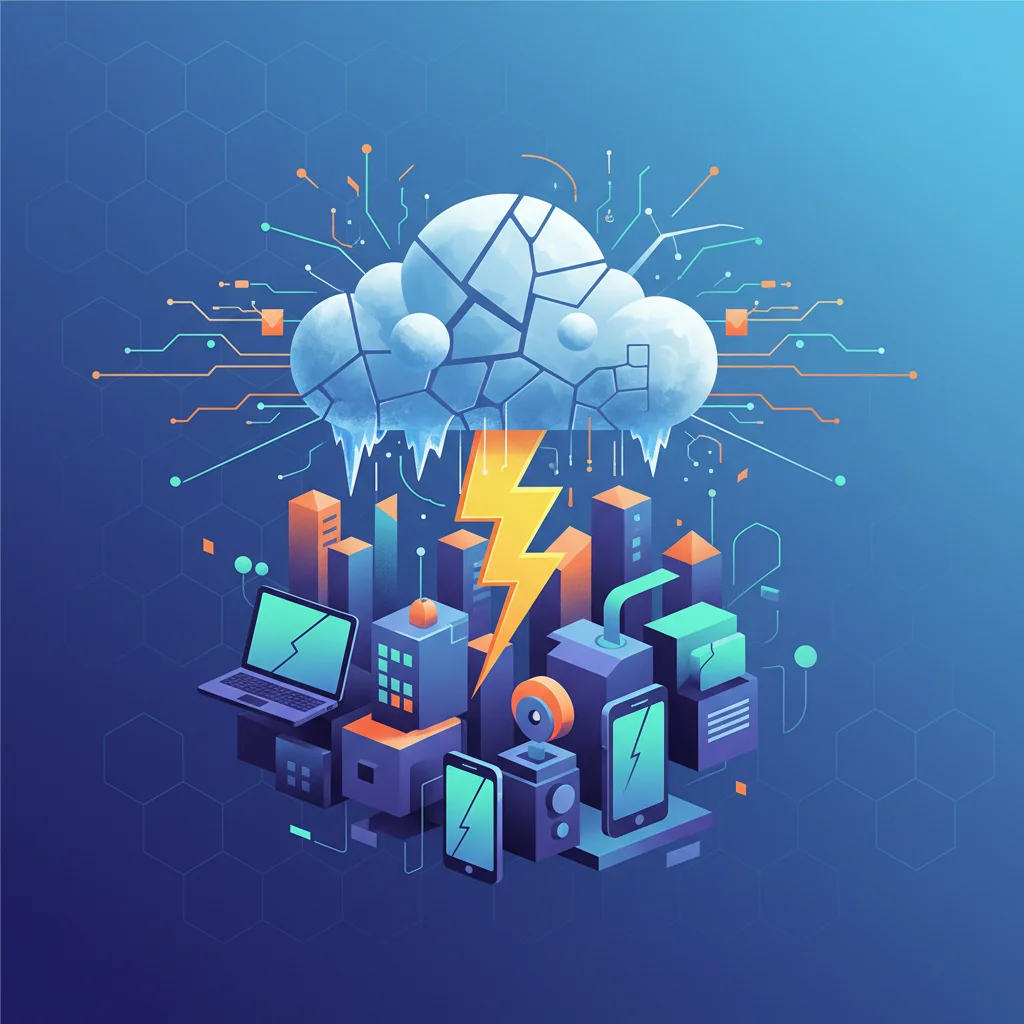
The Day the Cloud Stood Still: Lessons from the AWS Outage That Shook the Internet
Do you remember that day? The one where your smart doorbell wouldn’t connect, your favorite streaming service went blank, and your team’s project management tool suddenly felt like a ghost town? It wasn’t your Wi-Fi. For a few critical hours, a significant portion of the internet effectively held its breath. This wasn’t a scene from a sci-fi movie; it was the reality of a widespread Amazon Web Services (AWS) outage, a stark reminder of how much of our digital world rests on the shoulders of a few giants.
The event, which saw services like the US cryptocurrency exchange Coinbase and data services for the London Stock Exchange Group grind to a halt, wasn’t just a technical glitch. It was a critical wake-up call. It exposed the fragile interconnectedness of the modern digital ecosystem, a world built on the promise of the ever-available cloud. For developers, entrepreneurs, and tech leaders, it was a live-fire drill on the importance of resilience. For the general public, it was a peek behind the curtain at the complex infrastructure that powers our daily lives.
In this deep dive, we’ll dissect what happened during that major AWS outage, explore the cascading consequences, and, most importantly, provide an expert playbook on how your business—whether a nimble startup or an established enterprise—can build a more resilient future. Because in today’s economy, downtime isn’t just an inconvenience; it’s a direct threat to your bottom line and your reputation.
What Actually Happened? A Look Inside the US-EAST-1 Outage
The epicenter of this digital earthquake was AWS’s US-EAST-1 region, located in Northern Virginia. To understand the impact, you need to understand the significance of this specific location. US-EAST-1 is the original AWS region, launched in 2006. It’s one of the largest and most heavily used data center hubs on the planet. Many companies, especially startups, default to using it due to its long history and comprehensive feature set, making it a critical node in the global internet infrastructure.
On that particular day, an automated process designed to scale capacity within AWS’s internal network went awry. This triggered a cascade of failures that overwhelmed networking devices and ultimately impaired the ability of services to communicate with each other. The result? A massive service disruption that rippled across the web.
The impact wasn’t limited to a few obscure tech companies. The outage took down a who’s who of the digital world. Below is a snapshot of the diverse services affected, illustrating just how deeply AWS is embedded in our economy:
| Industry/Sector | Examples of Affected Services | Impact on Operations |
|---|---|---|
| Fintech & Crypto | Coinbase, Robinhood | Users unable to trade, check balances, or access accounts, causing financial anxiety and potential losses. |
| Media & Entertainment | Disney+, Netflix, IMDb | Streaming services failed, content libraries were inaccessible, and user engagement plummeted. |
| IoT & Smart Home | Ring Doorbells, iRobot Vacuums | Physical devices lost connectivity, rendering smart features useless and raising cybersecurity concerns. |
| Enterprise & SaaS | Slack, Asana, an LSE Group data feed | Business communication and project management stalled, halting productivity for countless companies. |
| Logistics & Delivery | Amazon’s own delivery operations | Warehouse scanners and delivery route applications failed, delaying packages and disrupting the supply chain. |
This wasn’t just a technical problem; it was an economic one. Studies have shown that the average cost of IT downtime can be staggering, with some estimates putting it at over $300,000 per hour for enterprises. For a high-volume platform like Coinbase, the financial and reputational costs are immeasurable.
The Price of 'Free': Why Meta's Italian Lawsuit is a Wake-Up Call for the AI-Powered World
The Illusion of the Infallible Cloud
The core of the issue is our collective dependence on centralized cloud infrastructure. AWS holds a commanding lead in the cloud market, with roughly 31% of the market share as of late 2023. While this concentration enables incredible economies of scale and rapid innovation, it also creates a single point of failure. When AWS sneezes, a large part of the internet catches a cold.
This event shattered the illusion for many that the cloud is an infinitely resilient, magical utility that “just works.” It’s a powerful tool, but it’s still built on physical servers, networks, and, crucially, human-written software and automation scripts that can fail. This is where the concept of shared responsibility becomes paramount.
The Architect’s Playbook: Building for a World Where Outages Happen
So, how do you protect your business? The good news is that the tools and strategies exist. It requires a proactive approach to architecture and a commitment to resilience from the earliest stages of programming and development.
1. Embrace Multi-Region Architecture
The simplest and most effective strategy is to not put all your eggs in one basket. A multi-region architecture involves duplicating your infrastructure and data in a separate, geographically isolated AWS region (e.g., having a live copy in US-EAST-1 and a failover in US-WEST-2). If one region goes down, you can use services like AWS Route 53 to automatically redirect traffic to the healthy region. This isn’t a simple switch to flip; it requires careful planning around data synchronization and state management, but it’s the gold standard for high availability.
2. Consider a Multi-Cloud Strategy
For mission-critical applications, some organizations go a step further with a multi-cloud approach. This means distributing your application across different cloud providers, like AWS and Google Cloud Platform (GCP) or Microsoft Azure. While this provides the ultimate protection against a single provider outage, it introduces significant complexity in terms of cost management, technical expertise, and interoperability. This is a high-level strategic decision typically reserved for large enterprises or highly sensitive workloads.
The Chip War Just Got Real: Why the Netherlands Seized a Chinese-Owned Tech Firm
3. Leverage Automation for Failover
When an outage strikes, time is money. Manually rerouting traffic and spinning up new servers is slow and error-prone. This is where automation is your best friend. By using Infrastructure as Code (IaC) tools like Terraform or AWS CloudFormation, you can define your entire infrastructure in code. This allows you to replicate your environment in a new region with a single command, dramatically reducing your Recovery Time Objective (RTO). Smart health checks and automated failover scripts are the cornerstones of a modern disaster recovery plan.
4. Practice Chaos Engineering
How do you know if your resilient architecture actually works? You test it. Chaos Engineering, a practice famously pioneered by Netflix, involves intentionally injecting failures into your system to identify weaknesses before they cause real-world outages. This could mean randomly terminating servers or blocking network connections in a controlled production environment. It’s the ultimate “practice like you play” for your engineering team, building both technical robustness and operational muscle memory.
The Future of Cloud: AI, Innovation, and the Unending Quest for Uptime
Outages like this are powerful catalysts for innovation. Cloud providers are investing heavily in using artificial intelligence and machine learning to build more self-healing infrastructure. AI algorithms can now predict potential hardware failures, detect network anomalies, and even automate complex remediation tasks before human engineers are even aware of a problem.
For businesses building on the cloud, especially SaaS companies, this event underscores the competitive advantage of resilience. A platform that stays online during a major outage earns immense customer trust. This is becoming a key differentiator in a crowded market. For startups, building with a resilience-first mindset from day one is far easier and cheaper than retrofitting it later. Simple choices, like using a multi-AZ (Availability Zone) database configuration, can provide a significant layer of protection with minimal overhead.
From Logistics to Lending: How AI is Unlocking Africa's Trillion-Dollar SME Market
Ultimately, the cloud is not infallible, and it never will be. It is a complex system of hardware, software, and human processes. The December 2021 AWS outage wasn’t the first major cloud disruption, and it certainly won’t be the last. But it served as a powerful, global-scale lesson. It taught us that true digital resilience isn’t about hoping for 100% uptime from our providers; it’s about architecting for a world where failure is not an ‘if,’ but a ‘when.’ By embracing this reality, we can build a stronger, more reliable, and more innovative digital future for everyone.


